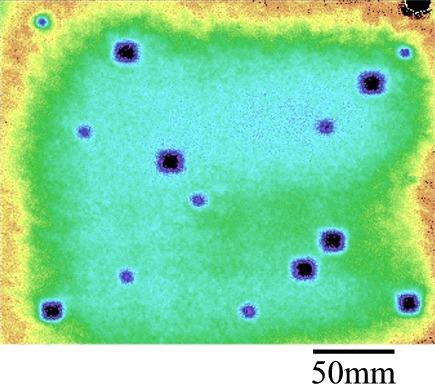home
> products
> BAT's
> BAT
examples
> example B.1.f
Air-coupled through-thickness C-scan of a Kevlar composite panel using BAT® transducers
The experiment:
MicroAcoustic
BAT transducers provide a practical non-contact alternative
for Non-Destructive Testing (NDT) of
composite materials. In this example, two non-contact BAT-1
transducers were used in a  through-transmission C-scan arrangement
(see figure at right) in order to image defects and variations within a
thin
Kevlar-fibre reinforced composite plate. The transducers in this case were placed a
distance of ~10cm apart in a coaxial configuration, and with the normal of
the plate parallel the transducer axes as shown. The source transducer was
excited into vibration using MicroAcoustic's
V-Pole and a ~400V
p-p toneburst voltage at frequency 280kHz. The toneburst frequency was
chosen so as to match to the nominal
through-thickness longitudinal resonance of the plate.
On the receive side, MicroAcoustic's
Q-Amp
transimpedance preamplifier was employed.
Because air-coupled inspection of composite materials is far more
practical than many people know, it is instructive to point out that no signal processing or image processing
was required to obtain the result below.
through-transmission C-scan arrangement
(see figure at right) in order to image defects and variations within a
thin
Kevlar-fibre reinforced composite plate. The transducers in this case were placed a
distance of ~10cm apart in a coaxial configuration, and with the normal of
the plate parallel the transducer axes as shown. The source transducer was
excited into vibration using MicroAcoustic's
V-Pole and a ~400V
p-p toneburst voltage at frequency 280kHz. The toneburst frequency was
chosen so as to match to the nominal
through-thickness longitudinal resonance of the plate.
On the receive side, MicroAcoustic's
Q-Amp
transimpedance preamplifier was employed.
Because air-coupled inspection of composite materials is far more
practical than many people know, it is instructive to point out that no signal processing or image processing
was required to obtain the result below.
The sample:
The sample was a thin
panel of Kevlar-fibre reinforced polymer having transverse dimensions of
approximately 300mm by 300mm. Within the sample were 14 simulated
delaminations. These delaminations were created by carefully embedding thin pieces of
Teflon tape of
different sizes and were introduced in such a way as to
replace some of the central fibers of the panel. The existence of the
defects was not
evident by visual inspection of the finished sample.
The resulting image:

The resulting C-scan image above is typical of the excellent images that can be obtained by MicroAcoustic's BAT® transducers when investigating composite materials without contact. Receive signal amplitude is here mapped (highest to lowest) according to orange, yellow, green, light blue, purple and finally black. The dark squares that appear reveal the positions of the simulated delaminations within the plate whereas the more gradual colour variations of the background (from blue-green in the middle to orange-yellow at the edges) are due to thickness variations not evident from visual inspection of the panel.
Conclusions:
1) This example shows that MicroAcoustic's BAT® transducers provide a practical non-contact alternative for the inspection and characterization of Kevlar-fibre composite materials.
2) Delaminations, inclusions, and thickness variations can all be easily detected and imaged in such composite materials using the MicroAcoustic's BAT®.
3) Because of their wide bandwidths, BAT® transducers allow tuning of toneburst drive frequencies to match nominal through-thickness resonances of samples. This greatly improves signal-to-noise ratios, and makes rapid air-coupled inspection of composite materials possible without signal averaging.
4) Unlike other air-transducers available (which have much narrower frequency bandwidths), MicroAcoustic's BAT® transducers can be used with a wide variety of materials and material thickness without the need to change transducers. This saves time and money, since only one set of BAT transducers are required for most of your inspection needs.
<< previous example ~ next example >>
*Note: The experimental results presented here were obtained by D.W. Schindel during his tenure at the NRC Institute for Aerospace Research. Contribution and reproduction of these results and figures occurs courtesy of the NRC Institute for Aerospace Research, Canada.
www.microacoustic.com